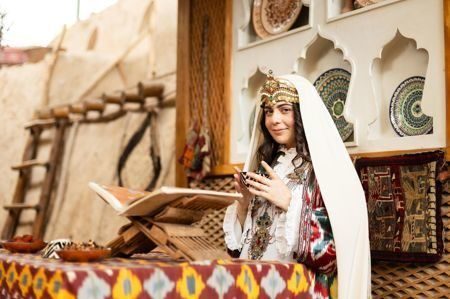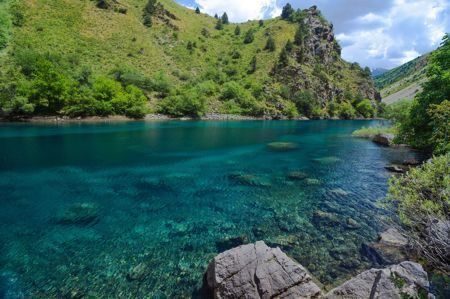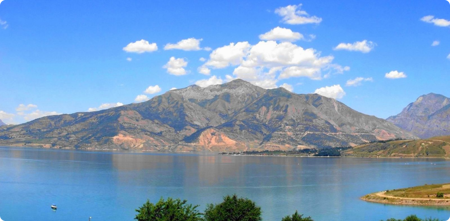
| About Samarkand / | Sights of Samarkand / | Master class in Samarkand |
History
In the 1st Millennium BC, the Holy book of Zoroastrians "Avesta" recorded on its pages a description of a developed agricultural area in the valley of the river Zerafshan (from the Persian - "Gold-bearing"”, in the South-East of modern Uzbekistan, where " high mountains abound with pastures and water, giving livestock abundant food, where deep lakes with a vast water surface and navigable rivers with wide channels...". The region is named in the Book – Sughd (Sogd), and, thanks to Alexander the great's biographer – Arrian, we know the name of its main city – Marakand, located in the area of present-day Samarkand, which is now conventionally 3000 years old.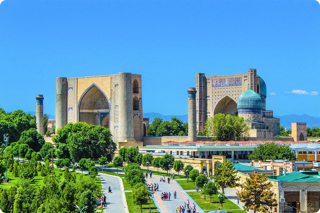
Information about Marakanda in the period before the Persian conquest (before the 6th century BC)is semi-legendary. Only one thing is known for certain: in the sixth century BC, expanding the borders of his state, the king of the Persians from the Achaemenid dynasty - Cyrus (Kurush) conquered, among other lands, and Sogd.
After almost two hundred years, the all-Greek Alliance under the leadership of Macedonia begins a war with Persia and defeats the great Persian army. In the spring of 329 BC, pursuing the Persian king Darius, the Greek-Macedonian army led by Alexander the great invaded the territory of Central Asia. After crossing the Amu Darya, the troops moved to the valley of Politimet (as the Greeks called Zerafshan “ " very valuable”) to Marakanda and captured the city.
But while Alexander will fight with the Scythians and lay the next, farthest Alexandria on the left Bank of the Syr Darya – Alexandria Eshata (in the area of Khujand, Tajikistan), an uprising will break out in Marakand, which will soon cover the entire Sogd. Spitamen, the name of a brave Sogdian, will lead a continuous partisan war and open battles with regular Macedonian army units for almost 2 years. But in the end, the heroic uprising will be brutally suppressed, Spitamen killed, and the city by order of the Macedonian conqueror - destroyed.
Exactly how long Marakanda remains in ruins is unknown, but the city will be revived in the South- Western part of the settlement of Afrosiab. According to ancient legends, cities are built to become a link between the will of the heavens and the will of the earth, and everything in the world will help to ensure that the connection between them is not interrupted. Samarkand has an epithet – Mahfuz, and for at least three thousand years, the city will be reborn, no matter what. Again and again.
Western part of the settlement of Afrosiab. According to ancient legends, cities are built to become a link between the will of the heavens and the will of the earth, and everything in the world will help to ensure that the connection between them is not interrupted. Samarkand has an epithet – Mahfuz, and for at least three thousand years, the city will be reborn, no matter what. Again and again.
Around 306 BC, Sogd would become part of the Seleucid state, named after Seleucus the First, one of the most talented generals of Alexander the great. Later the region will become part of the Greco-Bactrian Kingdom, and in the first centuries ad - under the rule of the Chinese guishuang dynasty (kangyu people of the Chinese province of Gansu), who created the Kushan Kingdom here. This interest of the rulers of neighboring countries in Samarkand was explained by its favorable geopolitical location – the largest caravan routes (the Great silk road) from Syria, Turkey, Persia, India, and China passed through the city.
Around the middle of the 5th century, the rulers of the Eftalite dynasty (the white Huns, descendants of the Massagets who once defeated the army of Cyrus) established their rule over the Central Asian lands, and later (in 565) nomadic Turkic tribes who came from the Altai. Samarkand, along with other cities of Sogd, retained its independence, but paid tribute to the Turkic rulers. In return, the Turkic Khaganate, which obtained the desired control over the caravan route from China to Byzantium, promised external peace and non-interference in state Affairs. At about the same time, The Arsis lead water main was laid through the city.
Some time later (in 712), the Arabs would March on Sogd. The invaders fired on the walls of Samarkand from three hundred and missile weapons, causing massive destruction.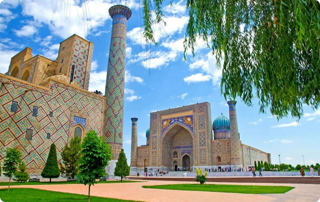 The Sogdians defended their city stoutly and courageously, inflicting serious losses on the attackers. The siege lasted for a month. When the walls were destroyed by catapults and the enemy entered the city, the battle did not end. The people of Samarkand fought for every house, for every piece of land. But in spite of such courageous resistance, the Arab troops under the leadership of qutayba Ibn Muslim occupied the city. Introducing a new religion and culture, historical values, written and cultural sources were destroyed. For this reason, the life of Samarkand before the Arab conquest is mostly known only through archaeological research and written sources of neighboring countries.
The Sogdians defended their city stoutly and courageously, inflicting serious losses on the attackers. The siege lasted for a month. When the walls were destroyed by catapults and the enemy entered the city, the battle did not end. The people of Samarkand fought for every house, for every piece of land. But in spite of such courageous resistance, the Arab troops under the leadership of qutayba Ibn Muslim occupied the city. Introducing a new religion and culture, historical values, written and cultural sources were destroyed. For this reason, the life of Samarkand before the Arab conquest is mostly known only through archaeological research and written sources of neighboring countries.
In early 713, an uprising breaks out in Samarkand. Then the steppe Turks will come to the aid of the Sogdian rebels. Popular unrest will accompany the entire period of Arab rule. Each new increase in pressure on local residents will cause a reaction in the form of uprisings. But the biggest revolt will break out in the 770s under the leadership of a man who went down in history under the Arabic nickname al-Mukanna ("covered with a white veil"). In 806, the desperate inhabitants of the Zerafshan valley and Kashkadarya, led by the military commander Rafi Ibn Leys, with the support of the Turks, pushed back the invaders. But the Arab Caliph will again assemble an army and personally lead a new campaign. In 809, Samarkand will be taken again. However, remembering the bitter experience of past uprisings, the Caliphate will return the right to rule the local nobility, obliging it, however, to periodically pay taxes.
The liberated Samarkand will begin to experience a new rise, will become the largest city in the region (up to half a million inhabitants), a haven for Sufis and scientists (in 1066-1070, Omar Khayyam, who specially arrived from Nishapur, lives here).  The city will bosomed in trees and gardens, abundance of flowering in the microclimate of a vast network quarterly pools (houses), fountains, craft paper, cotton fabric, glass, ceramics, jewelry, and all around will be replaced by the ruling dynasty: first Takhirids, then (in IX-X centuries) Samanids (who created the first Maurya centralized feudal state and a favorable environment for the development of science, culture, crafts and industry), at the end of X-XI centuries, Karakhanids, the Ghaznavids, Seljuk Sultanate, in the XII black-Chinese from Northern China and Khorezm shahs.
The city will bosomed in trees and gardens, abundance of flowering in the microclimate of a vast network quarterly pools (houses), fountains, craft paper, cotton fabric, glass, ceramics, jewelry, and all around will be replaced by the ruling dynasty: first Takhirids, then (in IX-X centuries) Samanids (who created the first Maurya centralized feudal state and a favorable environment for the development of science, culture, crafts and industry), at the end of X-XI centuries, Karakhanids, the Ghaznavids, Seljuk Sultanate, in the XII black-Chinese from Northern China and Khorezm shahs.
Meanwhile, in the East, the Mongol tribes are United under the rule of Temuchin, who will take the title of Dengiz Khan (Lord of the Ocean), better known as Genghis Khan… Genghis Khan's army will enter Samarkand on March 17, 1220. Despite the residents preparing for a siege, the local government will treacherously open the gates. Some will be killed, most will be captured for military purposes, and about 30,000 artisans and craftsmen will be taken to Mongolia. The city is devastated... Only to be reborn later.
Genghis Khan would die seven years later, having shortly before divided his Empire among his sons (Samarkand would pass to Chagatai, the second son of Genghis Khan). The Empire will agonize for almost a century and a half until Timur, a descendant of Genghis Khan's cousin, comes to power and creates his Empire from East to West - from Kashmir to the Mediterranean sea, and from North to South – from the Aral sea to the Persian Gulf, establishing Samarkand as the Imperial capital in 1370.
According to Timur's plan, the greatness and beauty of Samarkand should have eclipsed all the capitals of the world. “...From Damascus, he brought various masters, such as he could find. Those who weave different silk fabrics, or make bows for shooting and different weapons, or process glass and clay, which they have the best in the whole world.  From Turkey he brought archers and artisans, masons and goldsmiths, as many as there were. In addition, he brought engineers, bombers and those who make ropes for cars...”. Palaces, Gur-Emir, Bibi-Khanym, and a number of mausoleums of Shohi-Zinda are built by local and imported craftsmen, which still amaze with their beauty and grandeur. Samarkand is surrounded by 12 surrounding gardens, and the surrounding area is built up with villages with the names of such majestic capitals of the world as Misr (Cairo), Dimishk (Damascus), Baghdad, Sultania, Farish (Paris), etc.
From Turkey he brought archers and artisans, masons and goldsmiths, as many as there were. In addition, he brought engineers, bombers and those who make ropes for cars...”. Palaces, Gur-Emir, Bibi-Khanym, and a number of mausoleums of Shohi-Zinda are built by local and imported craftsmen, which still amaze with their beauty and grandeur. Samarkand is surrounded by 12 surrounding gardens, and the surrounding area is built up with villages with the names of such majestic capitals of the world as Misr (Cairo), Dimishk (Damascus), Baghdad, Sultania, Farish (Paris), etc.
Samarkand is being decorated, the Empire is growing, but there is only one danger-Tokhtamysh, the ruler of the Golden Horde, who only recently sacked Moscow, and in 1388 tried (unsuccessfully) to besiege Samarkand, taking advantage of Timur's absence from the city. In 1395, Timur's army of two hundred thousand completely defeated Tokhtamysh, and then destroyed the main city of the Golden Horde – the capital Sarai Berke. ... Once again, the lost trade routes from China to the middle East are being revived, and they converge again in Samarkand. At this time, in the South-West of the continent, the Ottoman Empire of the Turks is gaining strength, whose army in 1396 completely breaks the color of the knights of Europe and besieges Constantinople. The Regent of Constantinople, the Emperor of Greece, the ruler of Venice offer Timur to become an ally of Europe. Bayezid, the Sultan of the Ottomans, also offers him an Alliance… Timur makes his choice and on July 28, 1402, with his twenty-thousand-strong army of selected soldiers, defeats Bayezid at Ankara. 500 years later, the grateful French will install a gilded statue of Timur in Paris, which will be signed "Liberator of Europe".
4 years after the death of Timur (Timur will die in 1405 in the campaign against China), the country will  be ruled by his grandson – 15 – year-old Mirzo Ulugbek – a great scientist, whose 40-year reign will be held under the motto “the Pursuit of knowledge is the duty of every Muslim”. The main brainchild of Ulugbek is his University on Registan square and an Observatory that has no equal either then or many years later, in which observations of the starry sky were made. Ulugbek compiled an accurate Atlas of the sky of 1018 stars, "Gurganov" tables of natural values of the sinuses and tangents of the angles of the stars, correct to the ninth decimal point, as well as a catalog of geographical coordinates of a large number of points on the Earth25 October 1449 Ulugbek was killed by order of his own son Abdulatif… In 5 and a half months, Abdulatif will be executed, his head will be hung on the portal of Ulugbek madrasah, and the grave will be written "Parricide".
be ruled by his grandson – 15 – year-old Mirzo Ulugbek – a great scientist, whose 40-year reign will be held under the motto “the Pursuit of knowledge is the duty of every Muslim”. The main brainchild of Ulugbek is his University on Registan square and an Observatory that has no equal either then or many years later, in which observations of the starry sky were made. Ulugbek compiled an accurate Atlas of the sky of 1018 stars, "Gurganov" tables of natural values of the sinuses and tangents of the angles of the stars, correct to the ninth decimal point, as well as a catalog of geographical coordinates of a large number of points on the Earth25 October 1449 Ulugbek was killed by order of his own son Abdulatif… In 5 and a half months, Abdulatif will be executed, his head will be hung on the portal of Ulugbek madrasah, and the grave will be written "Parricide".
After Ulugbek, Samarkand will not be ruled for long by Timurid Zahiriddinbobur, the author of the famous memoirs "Bobur-nameh" and the founder of the Mughal state in India.
In the international sphere, the Empire will begin to lose its former borders. The Ottoman Turks would restore their former greatness, subjugate the entire middle East, and seize the ports of the Mediterranean through which the silk Road trade passed. The caravan routes through Samarkand again lose their significance. The decline of trade and handicraft production leads to stagnation in the economic life of the country. 
In the 16th century, the Sheibanid dynasty, which United the Turkic-Mongol tribes, almost destroyed all the ruling Timurid nobility, but in the process of fighting for power, the most influential representatives of the Sheibanids themselves died. The search for the Khan leads to the Ashtarkhanids (natives of Astrakhan) - relatives of the Sheibanids living in Bukhara. The capital is moving to Bukhara, but Samarkand is still a large city with continuing development of Sciences and crafts. The Uzbek language, which is spoken by representatives of the Humanities, is actively developing.
A century later, under the Mangits, Samarkand will be part of the Bukhara khanate, as a special constituent. At this time, the Emir of Samarkand, Bahoduryalangtush, will use his own funds to build two other madrassas (the Central one - Tillya-Kori and the right one-Sher-Dor) on Registan square.
The end of the 17th century and the first half of the 18th century is a time of troubles. There was a period (in the twenties of the 18th century) when Samarkand would be empty, tigers and wolves would live in the madrasah, and the population would barely number a thousand families, and then settled in a small part of it. Life in the city will be revived in the late 70s of the eighteenth century. Residents of some neighboring cities had to be relocated to the city, new neighborhoods were established, and the city and fortress walls were being destroyed. But the city will live again. Gardens will bloom again, and running water will run through the ditches.
 May 2, 1868 Samarkand was occupied by the troops of the Russian Empire and became the center of the Zerafshan district, and later (from 1887) – the Samarkand region. The role of Samarkand will increase even more in connection with the construction of a new “old caravan route” – in 1888, the city will be connected to the shores of the Caspian sea by rail.
May 2, 1868 Samarkand was occupied by the troops of the Russian Empire and became the center of the Zerafshan district, and later (from 1887) – the Samarkand region. The role of Samarkand will increase even more in connection with the construction of a new “old caravan route” – in 1888, the city will be connected to the shores of the Caspian sea by rail.
In 1917, the Soviet government will come. In 1991, it will end and Uzbekistan, along with other Soviet republics, will declare its independence.
On October 18, 1996, at the celebration of the 660th anniversary of Timur, the first President of Uzbekistan will present the city with the honorary order of Temur (Amir Temur) and propose to establish this day as the official Day of the City.
Climate and weather in Samarkand
The climate conditions in Samarkand are quite favorable, and the seasons are clearly defined. The winter period in Samarkand (the time of year when the temperature stays below 0 degrees) begins around the middle of November and continues until the middle of March. The winter here is not too frosty. The maximum freezing temperature drops to -10 degrees Celsius, while the average temperature at night is 12 degrees below zero. But frosts usually do not last longer than 3-7 days and alternate with constant thaws, when the temperature can reach 12-15 degrees above zero on the thermometer.
Autumn and spring in Samarkand pass very quickly and are barely noticeable. The summer period often begins at the end of March. Summer with an average daily temperature of 25-35 degrees above zero continues until mid-October. It is very hot in June and July. During the day, the thermometer passes the 40-degree mark.
Transport
Transport links in the locality are at a good level and are actively continuing to develop. Public transport is represented by buses produced at the local automobile production, minibuses, private and public taxi cars. An interesting (but logical) feature of the Samarkand taxi is the fact that most of the cars of this service are of the brand Daewoo Lexia. The city taxi has a bright yellow color, similar to new York.
Since 2017, the tram that ran in Samarkand in the period from 1943 to 1973 has been running again.
What to see in Samarkand
The main point that attracts tourists in Samarkand is Registan square. This unique beauty and grandeur of the city is one of the most beautiful squares in the world. From all sides, Registan seems to be embraced by majestic, amazing architectural monuments. Luxury palaces, ancient minarets and ancient mausoleums are located here in a cozy neighborhood. Each of these buildings is richly decorated and decorated, the fine work of masters covers literally every inch of the structures. It is impossible to overlook and not appreciate the beautiful madrasah Sher-Dor, Tilla Kari and Ulugbek.
Of course, a trip to Samarkand should start with Registan, but then you should explore the entire territory of the old city in detail. Here, tourists are very interested in the mausoleum of Ishrat-Khon, which plays the role of a tomb for female representatives of the Timurid dynasty. It is also worth paying special attention to the famous Ulugbek Observatory and several other tombs of extraordinary beauty, including the mausoleum of the prophet Daniel and the mausoleums of Al-Bukhari, Rukhabad and Khoja Ayudi-Darun.
Local residents treat the Timur Bibi-Khanym mosque with great awe and respect. Here, nearby, the tomb of Timur and representatives of his family was built.
Travelers should visit the Museum Of the history of Samarkand, two mosques — Namozgoh and Hazrat-khizr, and the AK-Saray mausoleum.
From the North to the border of the city also adjoins a unique attraction — the settlement of Afrasiab. From the South, it is framed by a unique architectural complex — the tombs of Shohi-Zinda.





